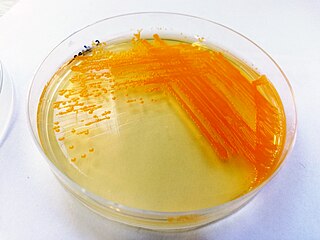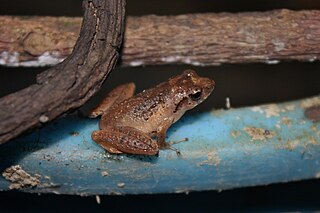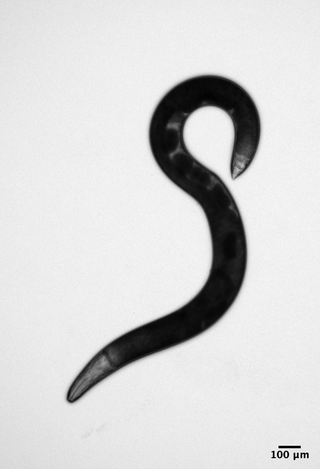
Rhabditida is an order of free-living, zooparasitic, and phytoparasitic microbivorous nematodes living in soil.

Fagus grandifolia, the American beech or North American beech, is the only species of beech native to North America. Its current range comprises the eastern United States, isolated pockets of Mexico and southeastern Canada. Prior to the glacial maximum of the Pleistocene epoch, the tree flourished over most of North America, reaching California.

Root-knot nematodes are plant-parasitic nematodes from the genus Meloidogyne. They exist in soil in areas with hot climates or short winters. About 2000 species of plants worldwide are susceptible to infection by root-knot nematodes and they cause approximately 5% of global crop loss. Root-knot nematode larvae infect plant roots, causing the development of root-knot galls that drain the plant's photosynthate and nutrients. Infection of young plants may be lethal, while infection of mature plants causes decreased yield.
Pratylenchus brachyurus is a plant parasitic nematode.

Anguina is a genus of plant pathogenic nematodes.

Foliar nematodes are plant parasitic roundworms in the genus Aphelenchoides. The three most economically important species are Aphelenchoides fragariae, A. ritzemabosi, and A. besseyi. Foliar nematodes are becoming a widespread and serious problem for the ornamental and nursery industries. A. fragariae causes damage on hundreds of different plants including chrysanthemum, begonia, gloxinia, African violet, cyclamen, and a wide variety of bedding plants and ferns, causing brown to black, vein-delimited lesions on leaf tissue, defoliation, and possible stunting of plants.

The nematodes, roundworms or eelworms constitute the phylum Nematoda. They are a diverse animal phylum inhabiting a broad range of environments. Most species are free-living, feeding on microorganisms, but many species are parasitic. The parasitic worms (helminths) are the cause of soil-transmitted helminthiases.

Chryseobacterium is a genus of Gram-negative bacteria. Chryseobacterium species are chemoorganotrophic, rod shape gram-negative bacteria. Chryseobacterium form typical yellow-orange color colonies due to flexirubin-type pigment. The genus contains more than 100 described species from diverse habitats, including freshwater sources, soil, marine fish, and human hosts.
Nanohaloarchaea is a clade of diminutive archaea with small genomes and limited metabolic capabilities, belonging to the DPANN archaea. They are ubiquitous in hypersaline habitats, which they share with the extremely halophilic haloarchaea.

Liuixalus is a small genus of rhacophorid frogs that are distributed in southern China. Some species now in Liuixalus were originally placed in Philautus. It is thought to be the most basal genus in the Rhacophorinae.
Pasteuria is a genus of mycelial and endospore-forming, nonmotile gram-positive bacteria that are obligate parasites of some nematodes and crustaceans. The genus of Pasteuria was previously classified within the family Alicyclobacillaceae, but has since been moved to the family Pasteuriaceae.
Phasmarhabditis (Greek: Phasma = (φάσμα ; rhabditis = is a genus of bacterial-feeding nematodes which are facultative parasites whose primary hosts are terrestrial gastropods. The name comes from Greek: Phasma- (φάσμα ; rhabditis = rod-like (ῥάβδος. The genus is made up of 18 species including P. hermaphrodita, P. californica, P. neopapillosa, P. papillosa, P. apuliae, P. bohemica, P. bonaquaense, P. huizhouensis, P. nidrosiensis, P. valida and P. tawfiki.

Caenorhabditis sinica, is a species of Caenorhabditis nematodes, belonging to the Elegans super-group and Elegans group within the genus. It is closely related to several species isolated from the lands adjacent to the Indian and Pacific Oceans, as well as to C. briggsae and C. nigoni. The species was known as “C. sp. 5” prior to 2014. C. sinica is known for having very high genetic diversity in its genome. Like other Caenorhabditis species, C. sinica is a ~1mm long roundworm with a transparent cuticle and that eats bacteria. Wild isolate strains of C. sinica have been collected from various rotting plant tissue substrates in temperate and tropical regions throughout China since its initial isolation in 2005.
Terranova is a genus of parasitic nematodes. Species from this genus are known to parasitise sharks, rays, sawfishes, teleosts and crocodilians.

Fergusonina, the sole genus in the family of Fergusoninidae, are gall-forming flies. There are about 40 species in the genus, all of them producing galls on Eucalyptus, Melaleuca, Corymbia, and Metrosideros species in Australia and New Zealand.

Allodiplogaster is a genus of nematodes (roundworms) in the family Diplogastridae that currently includes about 35 described species.
Tripylella is a genus of nematodes belonging to the family Tripylidae.
Aegialoalaimus is a genus of nematodes belonging to the family Aegialoalaimidae.
Calcarisporiellaceae is a family of fungi within the subkingdom Mucoromycota. It is the only family in the order Calcarisporiellales, class Calcarisporiellomycetes, subphylum Calcarisporiellomycotina and phylum Calcarisporiellomycota. It contains two known genera, Calcarisporiella and Echinochlamydosporium. The two genera each have one species.










